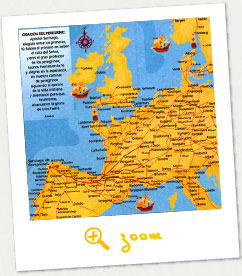
What is Compostela?
Map drawn by the late René de la Coste-Messelière, and included on Peter Robins's website.
Santiago de Compostela (St James of Compostela) is a town in Galicia , in northwest Spain . It is a place where an ancient tomb was found, early in the 9th century. The name "Compostela" comes from the Latin “campus” (field) and "stellae" (stars, lights). The tradition tells us that lights above a field led to the place where the tomb was dug out and rediscovered. It was then identified as that of the apostle and martyr St James the Great, a disciple of Jesus.
Before long, pilgrims came flocking from all over Europe . The pilgrimage reached its heyday in the 12th century, when it became easier to get there than Jerusalem which had become a very unsafe place to reach (after the terrible period of the crusades).
The last twenty years have seen an astonishing growth in the numbers of those traveling to Compostela. People go there for many reasons, and by no means are all of them religious, or even spiritual. Most people, though, find that their journey changes them in more or less profound ways.
According to the Gospel writer Matthew, there were, among the first disciples of Jesus, two brothers: James and John, sons of Zebedee, a fisherman (Mt 4: 21-22). And another Gospel writer, Mark, adds that Jesus gave to the two brothers the nickname of "Boanerges", which means sons of Thunder (Mk 3: 17). The reason for this is found in a passage of the third Gospel, Luke: the two brothers would have liked to invoke heavenly fire over a Samaritan village that had turned them away (Lk 9: 51-56).
It is said that this James, also referred to as James the Great, evangelized Spain. Upon his return to Palestine, Herod ordered that he be beheaded. His remains were later brought back to Galicia and buried there.








